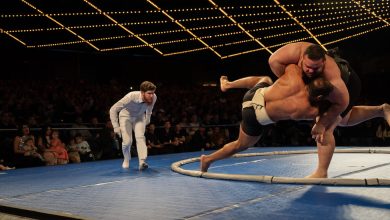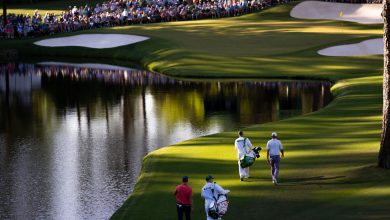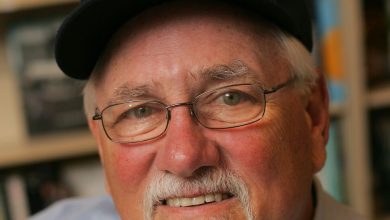He’s Baseball’s Only Mud Supplier. It’s a Job He May Soon Lose.

LONGPORT, N.J. — A 45-gallon rubber barrel sits in a cluttered garage along the Jersey Shore, filled waist-high with what looks like the world’s least appetizing chocolate pudding. It is nothing more than icky, gooey, viscous, gelatinous mud.
Ah, but what mud. The mud that dreams are made of.
This particular mud, hauled in buckets by one man from a secret spot along a New Jersey riverbank, is singular in its ability to cut the slippery sheen of a new baseball and provide a firm grip for the pitcher hurling it at life-threatening speed toward another human standing just 60 feet and six inches away.
Tubs of the substance are found at every major league ballpark. It is rubbed into every one of the 144 to 180 balls used in every one of the 2,430 major league games played in a season, as well as those played in the postseason. The mudding of a “pearl” — a pristine ball right out of the box — has been baseball custom for most of the last century, ever since a journeyman named Lena Blackburne presented the mud as an alternative to tobacco spit and infield dirt, which tended to turn the ball into an overripe plum.
Consider what this means: That Major League Baseball — a multi-billion-dollar enterprise applying science and analytics to nearly every aspect of the game — ultimately depends on some geographically specific muck collected by a retiree with a gray ponytail, blurry arm tattoos and a flat-edged shovel.

Bintliff is the owner of Lena Blackburne Baseball Rubbing Mud. The company is named for a former baseball player who discovered the mud in 1938.Credit…Hannah Beier for The New York Times
“Within the last six weeks, I’ve shipped to the Diamondbacks, the Rangers and the Blue Jays,” the mud man, Jim Bintliff, said recently, as he lingered protectively beside his garaged barrel of goop.
But M.L.B. executives do not exactly get all misty-eyed over the whimsical tradition of what is called Lena Blackburne Baseball Rubbing Mud, which they say is too often inconsistently applied. In their quest to make balls more consistent — and the game more equitable — they have tried to come up with a substitute, even assigning chemists and engineers to develop a ball with the desired feel.
The score so far:
Lena Blackburne: 1
Major League Baseball: 0
Glen Caplin, an M.L.B. spokesman, said that “pre-tack baseballs” are continuing to be tested in the minor leagues. But the reviews have been mixed.
“If you change one property of a baseball, you sacrifice something,” Caplin said. “The sound off the bat was different. The ball felt softer. The bar to change a ball is very high.”
Still, he said, “It’s an ongoing project.”
Bintliff knows the game isn’t over. He said that baseball’s apparent efforts to displace him and his mud used to disrupt his sleep. Now, he said, he’s become more philosophical.
“If they stopped ordering, I’d be more upset by the end of the tradition, not my bottom line,” he said, standing in his garage in red shorts and white high-top Chuck Taylor sneakers. “If they don’t want the mud, they don’t have to buy it.”
The tradition began with Russell Blackburne, a.k.a. Lena, a feisty, weak-hitting infielder who banged around the major leagues in the 1910s before settling in as a major-league coach and manager. A lifer, seen in black-and-white photos beside the likes of Ty Cobb and Connie Mack.
While coaching third base for the Philadelphia Athletics in 1938, he heard an umpire complain about the struggle to prepare brand-new balls for use. Blackburne experimented with mud from a Delaware River tributary, not far from his New Jersey home, and found that it de-glossed the ball while mostly maintaining its whiteness.
He now had a side job. After a while, every major and minor league team was using what sometimes came to be called “Mississippi mud” — though “mysterious” would have been more apt than Mississippi.
Before Blackburne died at 81 in 1968, he bequeathed the secret spot to an old friend who had joined him in mud harvesting: Bintliff’s grandfather, who left it to Bintliff’s mother and father, who, in 2000, passed it on to Bintliff.
Bintliff, 65, served in the Navy and worked for decades as a printing-press operator, but the mystical mud remained a constant in his life. Even now, he sees himself as he was in 1965, a rail-thin boy loading pails of freshly collected mud into the back of his grandfather’s Chevy Impala.
Over the years, Bintliff and his wife, Joanne, who handles the administrative work, have tinkered with the business model. For example, he used to harvest mud once or twice a year. But expanding their market to scholastic and professional football teams — including more than a few in the National Football League — has required monthly returns to the riverbank.
The fundamental work, though, remains the same, with timing dependent on the tide.
Bintliff will drive his Chevy Silverado pickup 70 miles or so to the secret spot and walk 50 yards through woods. Along with his shovel and buckets, he will have a machete for any overgrowth and a few fibs for any inquisitors. The mud does miracles for his garden, he might say.
Then back to his Jersey Shore home. The drive takes longer than the harvest.
For the next four weeks, Bintliff will strain the mud into the rubber barrel, skim the river water rising to the top, use plenty of tap water to eliminate odor, apply a “proprietary treatment” he declines to describe — and let the stuff settle.
“It ages like a fine wine,” he said.
When the mud has achieved its optimum vintage, he fills the outstanding orders — $100 for the 2.5-pound professional size, $65 for the 1.5-pound institutional size, and $25 for the 8-ounce “personal” size — and heads to the post office to ship some more mud-packed plastic containers.
Bintliff said his profit is modest. For example, he said, Major League Baseball pays less than $20,000 a year to have 10 pounds of the Lena Blackburne mud sent to each of the 30 major league teams. If a team needs more during a season, it deals directly with him.
He said he is motivated less by the money than by the wonder of it all. Imagine: This mud, containing a very particular mineral composition, is used to bless every major league baseball. And if the wonder escapes Major League Baseball, then, Bintliff said, “So be it.”
The question of where Lena Blackburne’s mud fits in today’s game comes as M.L.B. Commissioner Rob Manfred heads up the drive for consistency. But in a sport of countless variables, this pursuit can sometimes seem quixotic.
To begin with, baseballs are like snowflakes; though each one is handmade and held together with 108 red stitches, no two are identical. What’s more, they behave differently depending on the local environment — a challenge that M.L.B. has tried to address by requiring every ballpark to store baseballs in a humidor set at 70 degrees Fahrenheit and 57 percent relative humidity (The humidor for the Colorado Rockies ballpark is set at 65 percent relative humidity to adjust for the high altitude.).
The humidors are one reflection of the true preciousness of a mere baseball. Less than three inches in diameter and weighing about five ounces, it is the sun around which the game revolves — albeit a sun that soars, bounces, curves and eludes.
To ensure a replenishing supply of baseballs, M.L.B. has become part-owner of the Rawlings Sporting Goods Company, which manufactures major league balls in a factory in Costa Rica. The move also presumably gives M.L.B. some say-so in the finished product.
And to protect the baseball’s honor, M.L.B. has taken several steps, including cracking down on the doctoring of balls with Gorilla Glue-like substances that allow a pitcher to increase the spin rate and achieve almost Wiffle ball movement.
Still, there remains the messy matter of mud.
According to Caplin, the M.L.B. spokesman, the game’s front office began receiving complaints that some game balls were both lacking the desired grip and “chalky to the touch,” perhaps from lingering too long at the bottom of ball bags. M.L.B. began an investigation that included asking each of the 30 teams to send videos of their clubhouse employees “mudding” the balls for game-day use.
“What you found was 30 different ways of how to apply the mud,” Caplin said. “Some guys just used a towel, while other guys really rubbed it in, getting it ingrained into the leather.”
M.L.B. executives responded by sending a memorandum last month to every team with updated regulations for the “Storage and Handling of Baseballs.” The instructions for how to mud a baseball are Talmudic.
“All baseballs projected to be used in a specific game must be mudded within 3 hours of all other baseballs being used in that game, and must be mudded on the same day that they are going to be used … Baseballs should not be out of the humidor for more than two hours at any point prior to first pitch … Rubbing mud should be applied to each baseball for at least 30 seconds ensuring that mud is rubbed thoroughly and consistently into the entire leather surface of the ball … ”
The memorandum directed team employees to consult the “Mudding Application Standards” poster, on display in every clubhouse, to ensure that the color of a mudded ball is neither too dark nor too light, but just right.
Three big league teams — the Yankees, the Philadelphia Phillies and the Washington Nationals — declined to allow a reporter to watch a clubhouse employee engage in the seemingly innocuous but apparently sensitive task of rubbing mud into a baseball. Fortunately, M.L.B. also sent all teams a 50-second instructional video demonstrating the almost worshipful care expected in properly mudding a pearl.
A splash of water is poured into the jar of Lena Blackburne mud. The hands of an unknown clubbie dips three fingertips lightly into the mud, then selects a virgin ball from a box of a dozen. For the next 36 seconds, the hands rub, roll and massage, working the mud into the grain and along the seams before plopping the now off-white ball back in the box.
The simple act is surprisingly solemn, as if the integrity of the national pastime depended on communion between a ball made in Costa Rica and mud shoveled from a Jersey river.
But Jim Bintliff, the harvester of mud, knows better than most that the tides are forever changing. All he can do for now is to continue honoring a ritual begun by a mostly forgotten infielder from the dead-ball era who lives on with every thrown pitch.
The other day, Bintliff threw his flat-edged shovel into his pickup and headed again to the secret place. He came back with 20 pails of beautiful, mucky tradition.



